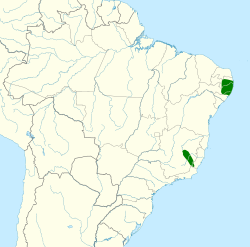Life History
Forbes's blackbird had an average lifespan of 4.6 years. It can eat insects, fruit and occasionally nectar from flowering plants or sugarcane. Its breeding season ranges from March to June, during the rainy season. Nests are most commonly found in mango trees (Mangifera indica). Egg clutch sizes can range between 1-4 eggs and it can have up to two clutches during the breeding season. After nest completion it can take anywhere between 4 and 10 days until egg laying starts. It is estimated that the population does not exceed 10,000 mature individuals.
Habitat and Range
Forbes's blackbird is a non-migratory species found in east and north-east Brazil in small and very fragmented habitats. Its natural habitats are subtropical or tropical moist lowland forest, subtropical or tropical seasonally wet or flooded lowland grassland, and plantations. The largest grouping found 150 individuals at Pedra Talhada, Alagoas. There are anywhere between 2-100 subpopulations, all of which are experiencing a continued decline of mature individuals. It has been found in small numbers around sugar cane plantations and pastures adjacent to forest patches and marshy areas. In the wild it primarily inhabits forest edge areas.
This page is based on this
Wikipedia article Text is available under the
CC BY-SA 4.0 license; additional terms may apply.
Images, videos and audio are available under their respective licenses.


